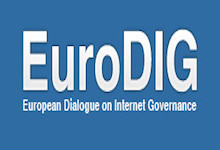Blockchain technology and internet governance
8 Jun 2017 02:00h
Event report
The session was moderated by Mr Walid A Saqaf, Internet Society, and was part of EuroDIG’s educational track. At the beginning, Mr Ken Hansen, Blockchain Roadshow, offered a simplified explanation on blockchain technology. He explained that blockchain is a distributed open ledger network with no single centralised point. It operates on the P2P (peer-to-peer) distributed application architecture. Hanson clarified that bitcoin is not synonymous with blockchain, it is just one of the applications that runs on a blockchain, such as ‘Ripple’ (financial transfers solution) or ‘FlightDelay’ (instant payout in case of a delayed flight).
After Hansen’s presentation, the interactive part of the session started. It was organised as a game in which the audience learned how blocks are created inside a blockchain. ‘Miners’ (volunteers from the audience),were working as block creators and were awarded with Yummi coins (chocolate bars). Miners serve as protectors of this distributed ledger, monitoring the transactions which take place in a blockchain. The audience learned why blockchain ensures the immutability of transactions by referring to everything that happens in a network.
Continuing the discussion, Mr Anton Zurenko, Stratum, addressed the question of trust on the Internet, and the question was raised: is blockchain a technology that can help? He pointed out that blockchain is a system that requires no trust, since everything is regulated by algorithms and mathematics. It is a system that makes sure that there is a shared protocol, but that each participant still retains independence.
Ms Hannahe Boujemi, blockchain researcher, added that there is no clear picture on what should be regulated. This technology is not yet mainstream and it would be good to wait a while longer with the regulations. The EU is taking this specific approach regarding regulation. Generally speaking, regulators do not have a lot of options at the money, and they need to leave it to the market to bring more clarity.
Mr Arvin Kamberi, DiploFoundation, pointed out that blockchain was developed as an answer to the loss of trust after the 2008 financial downfall. It was created as a response to the need for a decentralised trust system. He added that is important to distinguish that, aside from open blockchains (such as the bitcoin blockchain), other blockchain applications can include permissions, and adding additional layers of security and scalability. These blockchains would be managed in a centralised way, but would significantly help in reducing cost and increasing efficiency. On the other hand, open blockchains offer a new way of system governance by emerged consensus. Since the story of developing blockchains resembles the early days of the Internet and the discussions of standardisation, Kamberi added that we might need a similar solution (for example the multistakeholder model within the Internet Corporation for Assigned Names and Numbers – ICANN).
Mr Michael Oghia, Internet governance consultant, added that one important aspect of governance is the sustainability of blockchains. When it comes to blockchains, many applications will be developed, and this might lead to significant levels of energy consumption. He added that as we move forward, this issue should be incorporated as much as possible into the Internet governance discussions.
Questions from the audience addressed the issue of regulation. Regulation needs to be done in the context of specific sectors. If it has impact on the financial sector, it should be regulated there, but not as a technology in itself. It was concluded that the Internet, as we know it today, emerged as a platform that provides services. One can anticipate that blockchains will have a similar range of applications to build on top. Some of the most prominent players are involved in harnessing this new technology for their products. That has been recognised as the main challenge for future regulation.
Related topics
Related event

